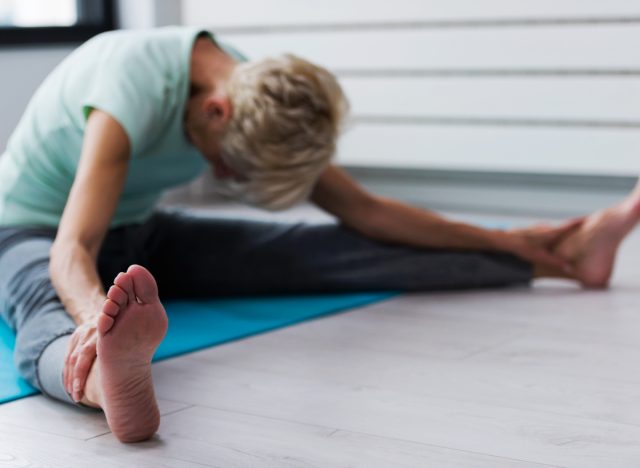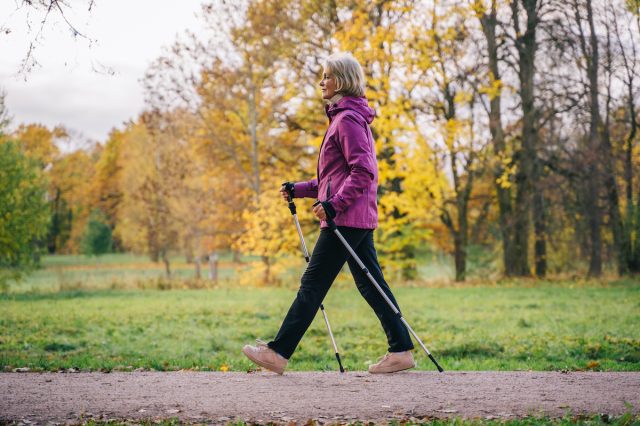This One Thing Can Predict Your Mobility As You Age, New Study Says

Frailty is often defined as a “clinically recognizable state of increased vulnerability resulting from aging-associated decline.” While that definition is quite scientific, you probably have a decent idea of what frailty refers to in more real-world terms. Frail individuals are usually weak, have poor balance, and are at an increased risk of suffering a fall and being hospitalized.
Frailty is largely a geraitric condition, which means it usually occurs in older individuals. Now, while frailty alone isn’t considered a disability, it is seen as a major risk factor, or in many cases even a precursor, to full-blown disability and loss of day-to-day functioning and independence.
The idea of losing your ability to function on a daily basis and complete basic tasks like bathing, getting dressed, and going shopping is no doubt scary. It goes without saying that anyone and everyone would want to know if they’re heading down a path that leads to frailty and disability. Contrary to what some believe, frailty is by no means unavoidable.
Diagnosing frailty in an individual, however, is a fairly complicated and lengthy process; physicians must assess the patient across five specific parameters: walking speed, unintentional weight loss, grip strength, physical activity levels, and exhaustion.
Now, fascinating new research published in the Journal of Cachexia Sarcopenia and Muscle reports a much easier, faster way to gauge how at risk an older adult (60+) is of losing their capacity to perform the basic activities of daily living years or decades later. Read on to learn more about this major warning sign of disability and frailty.
Gait speed predicts functional disability

The study concludes that a slow gait, or walking speed, is an accurate predictor of future loss of functional capacity. So, if a 63-year-old walks at a noticeably slower speed than his or her peers, that individual is more likely to be frail, and unable to perform basic living tasks independently by the time they turn 75 or 80.
“Our study showed that measuring gait speed alone is sufficient for efficient prediction of loss of functional capacity in older adults,” says principal study investigator Tiago da Silva Alexandre, a professor at UFSCar’s Department of Gerontology. “Based on our findings, we can say that slowness of gait precedes this loss by several years. This is an important result because it facilitates monitoring of the problem. It also enables not just physical therapists, clinicians, and geriatricians but also any health professional to detect the risk.”
Daily living activities were separated into two categories for this research: Basic activities of daily living (BADL), which covers getting out of bed, bathing, eating, walking, and dressing. Additionally, instrumental activities of daily living (IADL) cover slightly more complex daily chores like shopping, household cleaning, cooking, using transportation, and managing medications.
Related: Here’s How Far You Need to Walk Every Day to Live a Longer Life, Says Science
The research

Conducted by scientists from the Federal University of São Carlos (UFSCar) in the state of São Paulo, Brazil, and University College London in the United Kingdom, the study examined over 3,000 older adults (60+) living in England.
“Frailty is not a synonym for disability, but it’s a risk factor for loss of functional capacity,” Prof. Alexandre explains. “We assessed frailty syndrome on the basis of five symptoms or parameters. Subjects with one or two of these were classed as pre-frail and those with three or more as frail. This methodology is complex, requiring equipment and questionnaires. It’s not universally used.”
So, researchers investigated if each of the five main symptoms associated with frailty (walking speed, unintentional weight loss, grip strength, physical activity levels, and exhaustion) could better predict loss of everyday functioning than frailty itself.
For both older men and women, slowness of gait was found to be a stronger predictor of both BADL and IADL than frailty or the other four parameters.
Related: Sign up for our newsletter for the latest Mind + Body news.
Importance of early detection

Study authors stress that these findings may help improve the lives of countless people. Earlier detection of predicted loss of the ability to perform basic tasks opens the door for more treatment options and better odds of recovery.
“It’s an early indicator. The finding enables health professionals to detect a problem more easily. They can start sooner to investigate the causes of slowness,” adds the first study author Dayane Capra de Oliveira.
“It’s harder to start treatment when a subject already experiences difficulties in several daily activities,” Prof. Alexandre continues. “There are options, but the results aren’t as good as they can be when the problem is detected early on. That’s why it’s so important to offer a simpler, safer and cheaper approach to predicting loss of functional capacity.”
Related: The 7-Minute Walking Trick That Can Add Years to Your Life, Say Experts
Gender differences

Interestingly, the data also suggests that pre-frail women are more prone to functional disability than pre-frail men. Moreover, being deemed “pre-frail” in general only predicted disability in women.
These findings, however, may be influenced by the trend that men, in general, tend to die younger than women. Men are often more at risk of fatal diseases like cancer and lung disease and tend to drink more. In other words, pre-frail and frail men die in a faster manner than their female counterparts, perhaps before ever losing their day-to-day functioning.
“Along similar lines, our study also suggests that men undergo a very short process of decline toward disability due to these more serious diseases, which can lead to death quite quickly, whereas frailty and disability last longer in women,” Prof. Alexandre concludes.
All in all, the message is simple. If you notice you’re lagging behind on your next stroll with a few friends, talk to your doctor. There are likely lifestyle changes you can make today that will help you avoid frailty and maintain your independence in the years and decades to come.
For more, check out What a Daily Walk Does to Your Body After 60.








